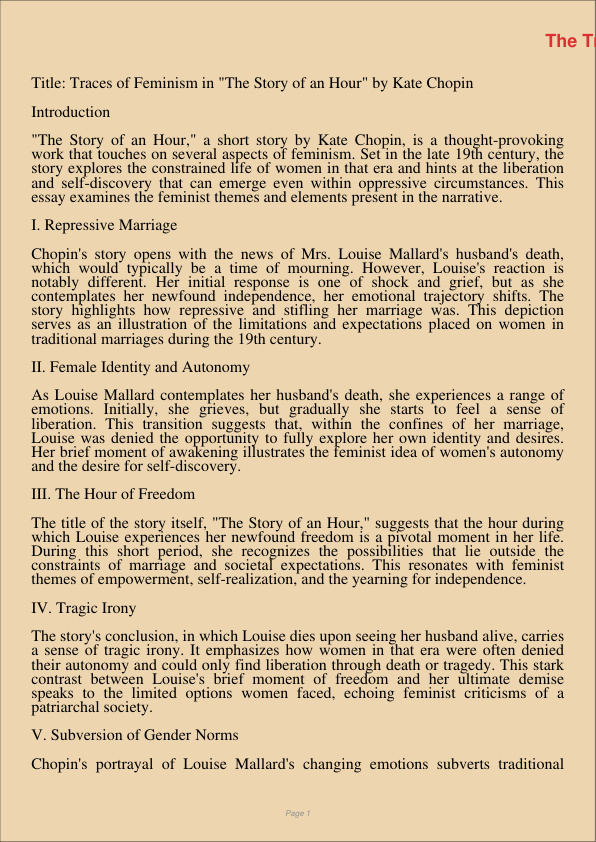The Traces Of Feminism In The Story Of An Hour A Short Story By Kate Chopin
Jan 12, 2024
kate chopin
short story
Environmental Studies
History
Title: Traces of Feminism in “The Story of an Hour” by Kate Chopin
Introduction
“The Story of an Hour,” a short story by Kate Chopin, is a thought-provoking work that touches on several aspects of feminism. Set in the late 19th century, the story explores the constrained life of women in that era and hints at the liberation and self-discovery that can emerge even within oppressive circumstances. This essay examines the feminist themes and elements present in the narrative.
I. Repressive Marriage
Chopin’s story opens with the news of Mrs. Louise Mallard’s husband’s death, which would typically be a time of mourning. However, Louise’s reaction is notably different. Her initial response is one of shock and grief, but as she contemplates her newfound independence, her emotional trajectory shifts. The story highlights how repressive and stifling her marriage was. This depiction serves as an illustration of the limitations and expectations placed on women in traditional marriages during the 19th century.
II. Female Identity and Autonomy
As Louise Mallard contemplates her husband’s death, she experiences a range of emotions. Initially, she grieves, but gradually she starts to feel a sense of liberation. This transition suggests that, within the confines of her marriage, Louise was denied the opportunity to fully explore her own identity and desires. Her brief moment of awakening illustrates the feminist idea of women’s autonomy and the desire for self-discovery.
III. The Hour of Freedom
The title of the story itself, “The Story of an Hour,” suggests that the hour during which Louise experiences her newfound freedom is a pivotal moment in her life. During this short period, she recognizes the possibilities that lie outside the constraints of marriage and societal expectations. This resonates with feminist themes of empowerment, self-realization, and the yearning for independence.
IV. Tragic Irony
The story’s conclusion, in which Louise dies upon seeing her husband alive, carries a sense of tragic irony. It emphasizes how women in that era were often denied their autonomy and could only find liberation through death or tragedy. This stark contrast between Louise’s brief moment of freedom and her ultimate demise speaks to the limited options women faced, echoing feminist criticisms of a patriarchal society.
V. Subversion of Gender Norms
Chopin’s portrayal of Louise Mallard’s changing emotions subverts traditional gender norms. It challenges the stereotype of women as dependent and emotionally fragile, highlighting the potential for resilience, strength, and personal growth. Louise’s brief rebellion against societal norms, even if short-lived, underscores the feminist message of challenging and redefining women’s roles.
Conclusion
Kate Chopin’s “The Story of an Hour” subtly weaves feminist themes into a concise narrative. It serves as a critique of the limitations and repressive nature of 19th-century marriages while emphasizing the yearning for female autonomy and self-discovery. Louise Mallard’s brief moment of liberation, though ultimately tragic, symbolizes the innate desire for independence that many women of her time felt. The story remains a timeless piece of feminist literature, continuing to resonate with readers as it sheds light on the ongoing struggle for gender equality and individual freedom.
